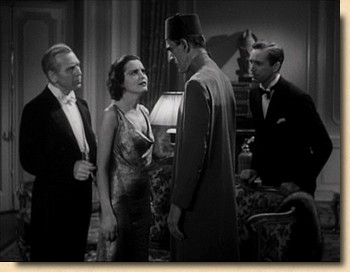| |
|
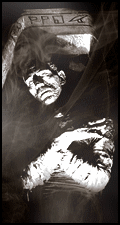 |
|
 SPOTLIGHT
ON SPOTLIGHT
ON
UNIVERSAL
MONSTERS:
THE MUMMY
(DARK
HORSE COMICS, NOVEMBER 1993)
|
|
|
|
| |
|
| |
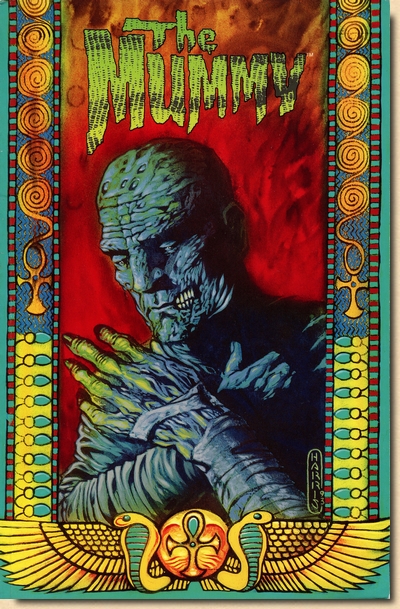
|
|
"The
Mummy"
(48 pages)
Script
(adaptation) -
Dan Jolley
Original story - Nina
W. Putnam, Richard Schayer
Original movie screenplay - John
L. Balderston
Pencils & Inks
- Tony Harris
Colours - Matt Hollingsworth
Lettering -
Lois Buhalis
Editor - Dan Thorsland
Cover - Tony Harris (pencils & inks)
On sale 30
November 1993
A Dark Horse Comics one-shot
adaptation
of the 1932 Universal movie The Mummy
SYNOPSIS
! SPOILER ALERT !
The year is 1921,
and deep in the Egyptian desert, the Reed
archeological expedition, led by Sir
Joseph Whemple, is digging for artefacts
for the British Museum. The results have
so far been disappointing, until the team
finally discovers and unearths the mummy
of an ancient Egyptian high priest named
Imhotep.
A closer
inspection of the mummy by Whemple's
friend, Dr Muller, rather surprisingly
reveals that the mummy's viscera were not
removed, as would have been common
practice. Furthermore, there are signs of
struggling, leading Muller to conclude
that although Imhotep had been wrapped
like a traditional mummy, he had in fact
been buried alive - along with a casket
carrying a curse.
|
|
|
| |
| It all points to a punishment and
execution for reasons of sacrilege, but despite Muller's
warnings, Sir Joseph's assistant Norton opens the casket
and finds an ancient life-giving scroll, the "Scroll
of Thoth". |
| |
|
He transcribes the
hieroglyphs and then translates the Old Egyptian
text, reading out the words aloud.
"This is the
Scroll of Thoth.
Herein are set down the magic words by which
Isis raised Osiris from the dead:
Oh! Amon-Ra
Oh! God of Gods
Death is but the doorway to new life
We live today
We shall live again
In many forms shall we return
Oh Mighty One."
The words re-animate
Imhotep, who grabs the scroll and slowly lumbers
out into the desert, leaving behind Norton in a
fit of hysterics that will ultimately put him in
an insane asylum.
Fast forward to 1932, and
Sir Joseph's son Frank Whemple is about to
abandon his expedition, not unlike his father ten
years prior, when a somewhat mysterious Egyptian
by the name of Ardeth Bey shows up. He promises
Whemple nothing short of the most sensational
find since the tomb of Tutankhamen and gives him
precise instructions on where to dig for the
final resting place of the Princess Ankhsenamun.
|
|
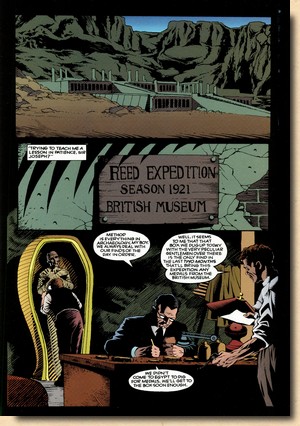 |
|
| |
| Bey's instructions - which he
claims stem from "partly inference, partly
chance" - lead to sensational archaeological
findings, but Whemple can't help but sense an odd aura
around the rather mysterious Egyptian, who amongst other
uncommon behaviour strictly avoids any physical contact -
"I dislike to be touched, an eastern
prejudice". |
| |
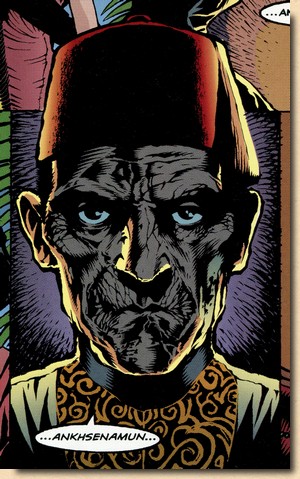 |
|
In Cairo, Dr Muller is hosting a
social event. One of the invited guests is Helen
Grosvenor, the half-Egyptian daughter of the
English governor of the Sudan. All of a sudden
she starts acting strangely and leaves the party
- unbeknownst to the baffled guests, she is under
a spell from Ardeth Bey who is reading from a
scroll inside the Cairo Museum of Antiquities. Helen ends up at the very
same museum, where she faints into the arms of
Frank Whemple. Much to the latter's surprise, she
then utters words in Old Egyptian, "not
heard on this earth for 2000 years".
When Bey is discovered with the scroll by a
museum guard he kills the witness but is forced
to leave in a hurry without the scroll, which
then ends up with Whimple, who is advised by
Muller to burn it. Precisely at this moment
Ardeth Bey shows up, and upon introductions is
clearly taken with Helen. The topic of the scroll
arises, and Bey starts to cast a spell on Sir
Joseph but leaves when Muller threatens to
destroy the scroll.
Back at his place, Ardeth
Bey performs a mystic ritual allowing him to
choke Sir Joseph to death long-distance, while
his Nubian servant retrieve the scroll.
Drawing Helen to his home,
he shows her visions in the pool of the house,
depicting the death of Princess Ankhsenamun,
priestess of the temple of Karnak, in 18th
Dynasty Egypt. In violation of all religious
laws, high priest Imhotep steals the Scroll of
Thoth from a statue of Osiris in order to revive
his beloved princess. In the midst of the ritual,
he is found out, and condemned by the Pharaoh to "nameless
death" and live mummification. The
scroll was buried with him prevent future such
sacrilege. As Ardeth Bey tells Helen, "my
love has lasted longer than the temples of our
gods, no man ever suffered as I did for you".
|
|
| |
| Bey is clearly Imhotep, and he is
convinced that Ankhsenamun is reincarnated in Helen, and
that she must undergo the ritual of the "great
night of terror and triumph" in order to have
an eternity of love at his side. |
| |
| However, Whemple and Muller have
started to put together the pieces and understand
the threat that Bey/Imhotep poses to all of them,
including Helen, who returns to her home in quite
a state. An attempt by Bey
to put a curse on Whemple is fouled by an Isis
charm he carries, but Helen returns to the
Egyptian under a renewed spell, where he has her
dress in Old Egyptian royal attire.
At this point, Bey
explains why he doesn't simply raise the remains
of Ankhsenamun with the power of the scroll - "it
would be a mere thing that moved at my will
without a soul". Instead, he plans to
kill and embalm Helen and then revive her as the
princess in immortality.
Helen, speaking as
Ankhsenamun, pleads with Bey, but he can't be
moved, refering to his own ordeal in the past. At
this point Whemple and Muller arrive on the
scene, witnessing Bey attempting to stab Helen
with a dagger but then struck down by a statue of
Isis that mysteriously raises its hand. Bey
disintegrates, and Whemple has to call Helen back
from across the centuries while the Scroll of
Thoth is destroyed by fire.



|
|
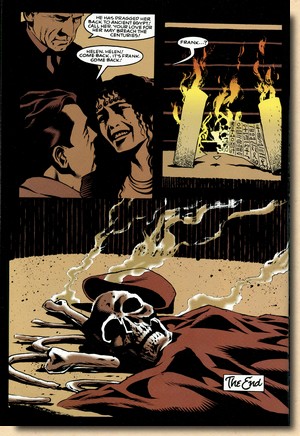 |
|
| |
|
| |
| |
